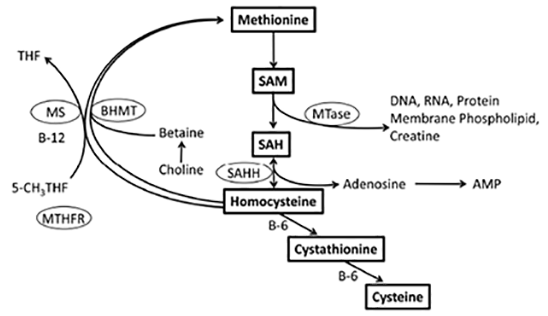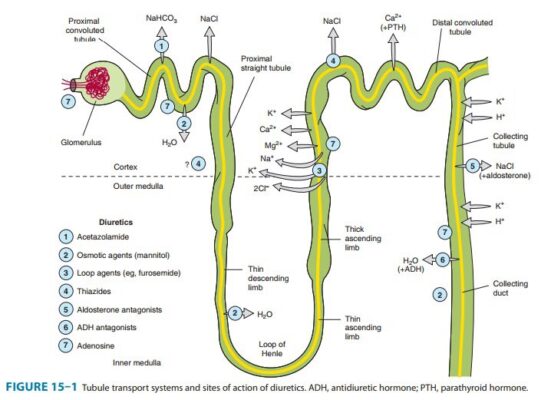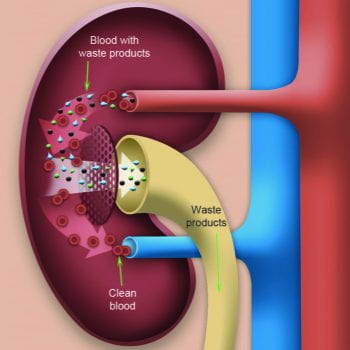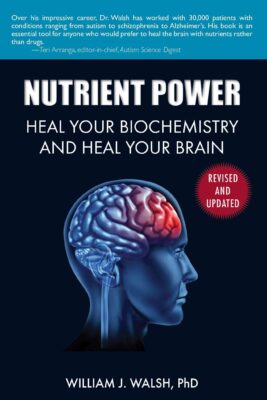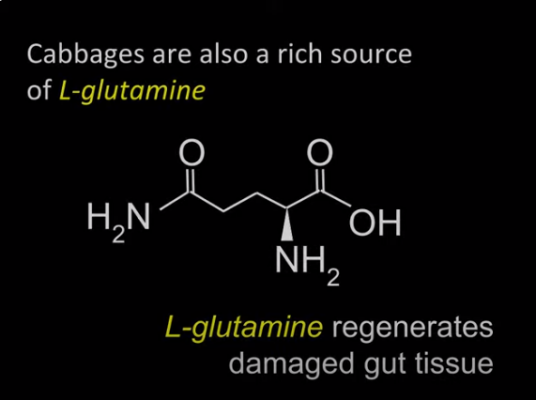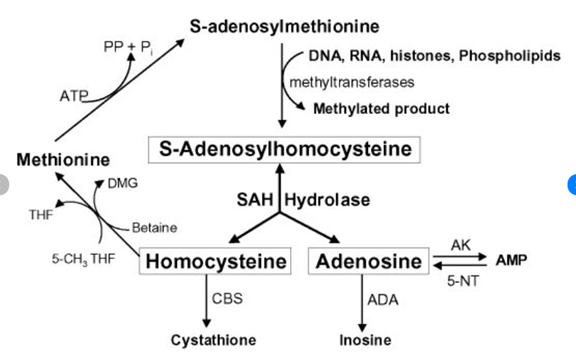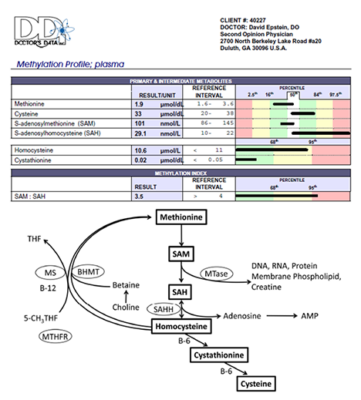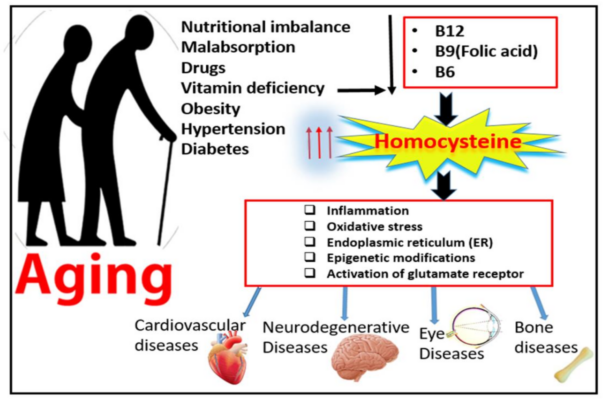Improving Mental Health; When Undermethylation is Exacerbated by Elevated Levels of SAH
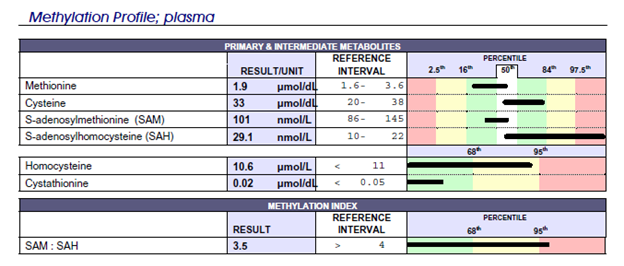
SAM/SAH Ratio in Methylation Status: Its Implications
The SAM/SAH ratio, as per Dr. Walsh, is a key factor in determining methylation status. Doctors Data provides an excellent test panal for evaluating methylation status when undermethylation is likely. An imbalance, particularly undermethylation marked by high S-adenosylhomocysteine (SAH) levels, can affect neurotransmitter activity and potentially lead to mental health conditions. This underlines the importance of managing high SAH levels.
Neurotransmitter Activity and Mental Health: Methylation's Role
Methylation, a crucial biochemical process involving the transfer of a methyl group (-CH3) to a molecule, significantly impacts the production of neurotransmitters like serotonin and dopamine. Dr. William Walsh's studies on methylation have illuminated that the activity of these neurotransmitters holds more importance than their mere production. This principle is foundational in the development of newer antidepressant medications, like selective serotonin reuptake inhibitors (SSRIs), that precisely modulate neurotransmitter activity.
Summary of Dr Walsh's comments on physician forum regarding the impact on methylation of the SAM:SAH ratio
Understanding Elevated SAH Levels
When SAH, S-Adenysyl-homocysteine, levels are significantly elevated (beyond the 50th percentile), this typically suggests a blockage in the conversion process of SAH to homocysteine and adenosine. Such blockages can be attributed to numerous factors, such as a genetic variant in the SAHH enzyme or impaired metabolism or removal of homocysteine or adenosine. The kidneys play a significant role in the removal of SAH.
The SAM/SAH ratio serves as a reliable indicator of an individual's methylation status. A ratio above seven signifies that an individual is not undermethylated, while a ratio below 6.0 points towards some degree of undermethylation. Those with ratios below 4.0 are severely undermethylated. It's crucial to note that a patient with an elevated SAM and methionine, and a SAM/SAH ratio of 5.6, is roughly akin to a histamine level of about 80 ng/ml. In cases with high SAH, it's evident that the inhibitory power of SAH becomes pronounced, making the SAM/SAH ratio an essential metric.
In certain situations, focusing on reducing SAH levels is imperative. For instance, when homocysteine levels are normal, but SAH is elevated, it may be due to an inability to metabolize adenosine. Factors like zinc depletion, high oxidative stress, and high ROS can inhibit adenosine metabolism. Addressing these issues, such as bringing plasma zinc levels to an ideal range and providing strong antioxidant support, may aid in reducing SAH levels.
The Significance and Caution Surrounding Folate Supplementation
Folates are commonly recommended for undermethylated individuals. However, they are contraindicated for severely low-serotonin patients. While folates can assist in fixing the one-carbon cycle, they can also negatively impact serotonin, dopamine, and norepinephrine neurotransmission. Specifically, folates intensify serotonin reuptake, which is detrimental for such patients. The methyl/folate ratio remains a pivotal consideration in many mental illnesses. For undermethylated patients with mental illnesses, it's generally advised to avoid folic acid, folinic acid, and methylfolate, as they can worsen their condition.
When addressing methylation imbalances, especially concerning neurotransmitters, it's paramount to consider DNA methylation. Initial interventions could include increasing serotonin activity using SAMe. Thereafter, based on insights from tests like the DDI or Genova SAM/SAH testing, targeted treatments that avoid folates can be considered.
The Importance of Zinc
Zinc is a crucial element that aids in the metabolization of adenosine via a zinc-dependent enzyme. Hence, in situations where SAH levels are high, the primary focus, as per Dr. Walsh's approach, is given to managing the patient's SAH levels and addressing the inability to metabolize adenosine. This entails optimizing plasma zinc levels and providing strong antioxidant support.
Moreover, dietary modifications, such as adopting a gluten-free, casein-free diet, might be beneficial in normalizing adenosine. However, it is crucial to remember that methionine or SAMe should not be administered until SAH levels have been adequately reduced.
Dr. Walsh's Analysis of Differing Methylation Panel Results
Dr. William Walsh has analyzed the methylation statuses of eight distinct patients through the Doctor's Data Plasma Methylation Panel. Each patient presented a different biochemical profile, with variances in SAH, SAMe, methionine, and homocysteine levels. In response to these distinct profiles, Dr. Walsh emphasized the need for individualized treatment strategies tailored to the unique biochemistry of each patient.
Scenario 1: 63-year-old man with health issues including kidney disease following a liver transplant, pyroluria, and chronic smoking
In this unique patient situation, Dr. Walsh was able to note considerable improvements through targeted zinc supplementation. The patient, a 63-year-old man with a complex health history that includes kidney disease following a liver transplant, pyroluria, and a history of chronic smoking, presented with elevated SAH levels. It was discerned that this elevation was partially due to a zinc deficiency caused by the patient's pyroluria.
Scenario 2: High SAH and Normal Homocysteine Levels
In this case, the elevated SAH might be due to an adenosine build-up rather than an issue with the methylation cycle. The treatment focus shifts towards normalizing adenosine levels rather than manipulating the methylation cycle. This includes ensuring optimal plasma zinc levels, providing strong antioxidant support, and potentially introducing a gluten-free, casein-free diet.
Scenario 3: Undermethylation with Low or Normal Homocysteine
Here, the patient exhibits undermethylation along with low-normal homocysteine levels, indicating a potential block in SAMe synthesis or a severe SAH elevation. Dr. Walsh recommends identifying the cause of the high SAH levels to decide the appropriate treatment strategy.
Scenario 4: Elevated SAH with Normal or Low Serum Copper and Undermethylation
Undermethylation often occurs with low-normal serum copper. The treatment focus would be to promote the conversion to adenosine and homocysteine. However, methionine or SAMe should not be administered until SAH levels have been reduced.
Scenario 5: Elevated SAH with Undermethylation and Increased NMDA Activity
Undermethylation treatment should focus on regulating misbehaving neurotransmitter systems rather than adjusting the methylation cycle. Undermethylation often co-exists with low serotonin activity and excessive NMDA receptor activity. Successful nutrient therapy to lower SAH levels could be followed by SAMe treatment or the use of an SSRI.
Scenario 6: Elevated SAH, SAMe, and Methionine with Undermethylation Symptoms
Even when SAMe and methionine levels are high, undermethylation might still exist based on the methylation profile. Diagnostic testing is crucial to correctly identify methylation status and inform treatment strategies.
Scenario 7: Undermethylation, Pyroluria, and Multiple Sclerosis (MS)
This scenario focuses on the association between undermethylation, pyroluria, and MS. Supplementing B-6 and antioxidants is recommended in cases with elevated pyrroles, along with normalizing D3 levels and avoiding extreme vitamin D levels.
Scenario 8: Early Intervention with Schizophrenia in a Teen with Severe Overmethylation
Emphasizing early intervention in schizophrenia, particularly within the first 3-5 years after onset, can lead to notable improvement. Understanding the patient's methylation status can help tailor treatments to promote significant improvement in symptoms.
These scenarios underline the crucial role that methylation status plays in understanding and treating various mental health conditions, emphasizing the importance of early diagnosis, personalized treatment strategies, and continuous management.
In each of these scenarios, the Walsh approach of personalized treatment is of great relevance, taking into account the complexities of biochemistry, the specific symptoms and conditions presented by the individual, and the potential interaction between various aspects of their health status.
In addition to these strategies, ensuring efficient kidney function and proper disposal of SAH can support balanced methylation processes. This can be achieved through lifestyle modifications, dietary changes, and potentially, targeted supplementation or therapies.
The Kidney's Role in Methylation and Sulfur Amino Acid Metabolism; Implications for Mental Health
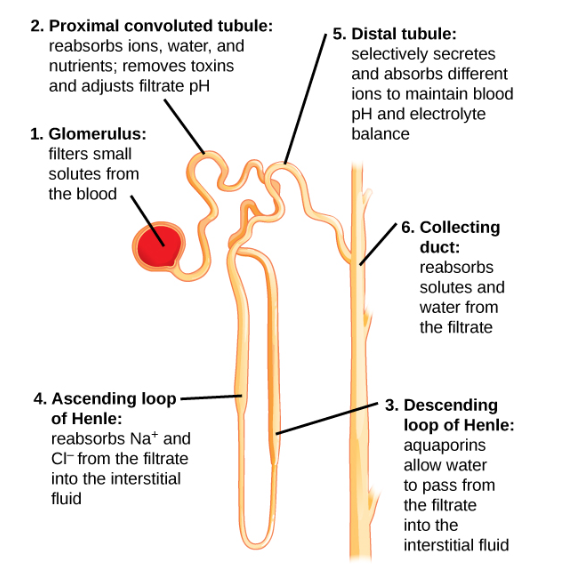
According to a study titled "The kidney is the major site of S-Adenosylhomocysteine disposal in humans", the kidney plays a pivotal role in sulfur amino acid metabolism, which directly impacts SAH levels. The study underpins Walsh's emphasis on the SAM:SAH ratios, highlighting that the efficiency of methyltransferase reactions depends on the effective tissue removal of SAH.
SAH, a potent feedback inhibitor of most methyltransferases, is a metabolic precursor of homocysteine in all tissues. It controls overall transmethylation rates, reinforcing the significance of efficient SAH removal for effective methyltransferase reactions.
The kidneys filter blood, eliminate waste products, and balance electrolyte levels in the body. They maintain overall body homeostasis, including the management of sulfur amino acid levels. When the kidneys are not operating efficiently, they may fail to effectively clear SAH from the blood. This can potentially lead to an accumulation of SAH, disrupting the methylation process and triggering health issues. For instance, elevated SAH levels are linked to undermethylation, which is associated with numerous mental health conditions.
Dietary and Lifestyle Changes for Improved Kidney Function
Improving kidney function can help in the efficient removal of S-adenosylhomocysteine (SAH). Several strategies, including dietary changes, lifestyle modifications, and targeted supplements or therapies, can support kidney health and function:
- Diet: A diet rich in fruits, vegetables, lean proteins, and whole grains.
- Hydration: Proper hydration aids the kidneys in filtering waste from the blood.
- Exercise: Regular physical activity helps manage blood pressure and weight.
- Blood Sugar Control: Keeping blood sugar levels in a healthy range can prevent or delay kidney damage.
- Limit Alcohol and Quit Smoking: Both alcohol and smoking can negatively affect kidney function.
- Blood Pressure Management: High blood pressure can damage the kidneys over time.
- Supplements: Omega-3 fatty acids, Vitamin C, Vitamin D, Probiotics, and Coenzyme Q10 have been suggested to have potential kidney benefits.
- Peptides: BPC-157, a peptide known for its regenerative and healing properties.
- Herbal Extracts: Astragalus, Cinnamon, Turmeric, and others may have kidney protective effects.
- Prescription Medications: Medications may be used to manage underlying conditions affecting kidney health.
- Low Protein Diet: A low-protein diet can decrease the kidneys' workload.
- Kidney Glandulars: Some practitioners report seeing benefits from the use of animal tissues or extracts to support human organ function.
- Traditional Chinese Herbs: Astragalus, Rhubarb, and Cordyceps have been used for centuries to support kidney health.
- Infrared Saunas: They can increase blood flow and promote sweating, aiding in waste removal.
- Ozone Therapy: This therapy has been suggested to improve cellular oxygenation and promote detoxification.
As always, it is vital to consult a healthcare provider before starting any new treatment plan, especially if you have existing health conditions like kidney disease. Not all treatments are suitable for everyone, and it's essential to weigh potential risks and benefits.

